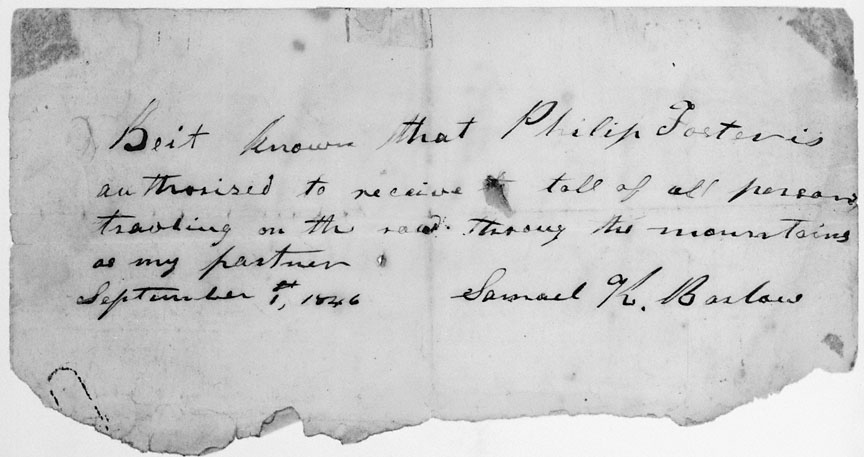- Catalog No. —
- OrHi 47206
- Date —
- September 1, 1846
- Era —
- 1846-1880 (Treaties, Civil War, and Immigration)
- Themes —
- Environment and Natural Resources, Oregon Trail and Resettlement, Transportation and Communication
- Credits —
- Oregon Historical Society
- Regions —
- Cascades Central Oregon Trail
- Author —
- Samuel K. Barlow
Barlow Road Toll Collection Authorization
This note, signed by Samuel K. Barlow, authorized Philip Foster to collect tolls from emigrants using the Barlow Road to cross the Cascades on their way to the Willamette Valley.
The history of the Barlow Road began in the mid-1840s when large wagon trains of American emigrants were making their way to Oregon from the Midwest. In the fall of 1845, hundreds of emigrants finally reached The Dalles, where they faced a logistical crisis. Only a limited number of boats were available to ferry the overlanders down the Columbia, and local food stores were dangerously low. Faced with this grim situation, several families elected to try crossing the Cascade Range rather than wait indefinitely at The Dalles for passage to Fort Vancouver. Headed by Sam Barlow and William Rector, these families set out along the Deschutes River in late September 1845. They were later joined by a second party led by Joel Palmer. Their objective was to find a southern route around Mt. Hood.
While earlier Native and non-Native travelers had crossed the Cascades, none had driven wagons over the mountain range. The emigrants’ attempt proved quite harrowing, but ultimately successful. After caching their wagons and extra supplies five miles south of Barlow Pass, the emigrants made their way on foot and on horseback down the western slope of Mt. Hood. They finally arrived in small parties at Philip Foster’s farm at Eagle Creek—present-day Clackamas County—in late December 1845. The emigrants made their way to Oregon City, subsequently returning to bring their wagons and remaining goods down Mt. Hood after the spring snow melt.
In the meantime, Barlow applied to the Oregon Provisional Government for a charter to operate a toll road across the Cascades along the route the emigrants had taken. The government granted Barlow a charter to construct a road from Oregon City to the eastern slope of the Cascades. With his partner, Philip Foster, Barlow employed some forty men over the spring and summer of 1846 to complete the road. In the fall of 1846, the Barlow Road became a regular route for emigrants traveling along the Oregon Trail to the Willamette Valley. For the next seventy years, various owners operated the toll road, making route changes from time to time. In 1919, George W. Joseph, the current owner, deeded the Barlow Road to the state of Oregon. Today, most of the road is only accessible to hikers; however, the section of Highway 26 from Government Camp to Sandy generally follows the route of the original road.
Further Reading:
Meacham, Walter. The Barlow Road. Portland, Oreg.: 1947.
Bailey, Walter. “The Barlow Road.” Oregon Historical Quarterly 13, 1912: 288-295.
Barlow, Mary S. “History of the Barlow Road.” Oregon Historical Quarterly 3, 1902: 71-81.
Odgers, Charlotte. “Philip Foster: Pioneer Oregon Entrepreneur.” Reed College Bulletin 21, 1942: 29-39.
Written by Melinda Jette, © Oregon Historical Society, 2004.
